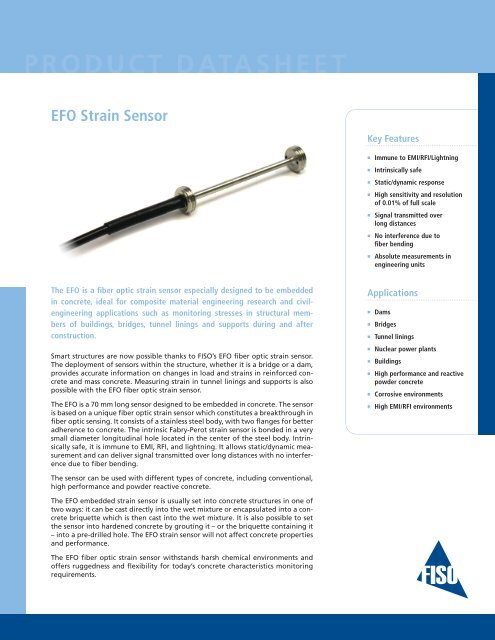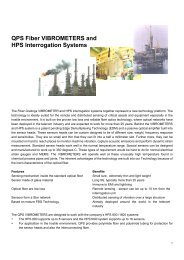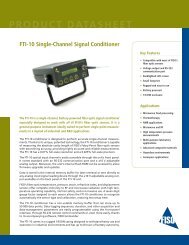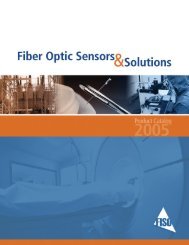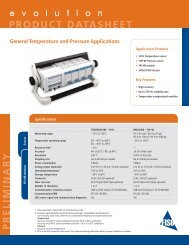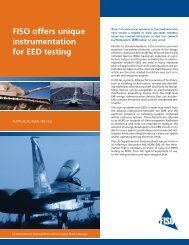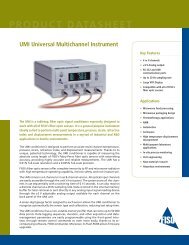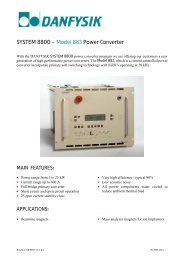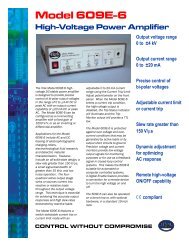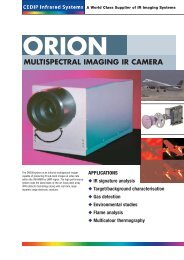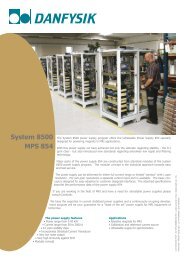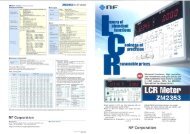EFO Strain Sensor
EFO Strain Sensor
EFO Strain Sensor
Create successful ePaper yourself
Turn your PDF publications into a flip-book with our unique Google optimized e-Paper software.
<strong>EFO</strong> <strong>Strain</strong> <strong>Sensor</strong><br />
Key Features<br />
• Immune to EMI/RFI/Lightning<br />
• Intrinsically safe<br />
• Static/dynamic response<br />
• High sensitivity and resolution<br />
of 0.01% of full scale<br />
• Signal transmitted over<br />
long distances<br />
• No interference due to<br />
fiber bending<br />
• Absolute measurements in<br />
engineering units<br />
The <strong>EFO</strong> is a fiber optic strain sensor especially designed to be embedded<br />
in concrete, ideal for composite material engineering research and civilengineering<br />
applications such as monitoring stresses in structural members<br />
of buildings, bridges, tunnel linings and supports during and after<br />
construction.<br />
Smart structures are now possible thanks to FISO’s <strong>EFO</strong> fiber optic strain sensor.<br />
The deployment of sensors within the structure, whether it is a bridge or a dam,<br />
provides accurate information on changes in load and strains in reinforced concrete<br />
and mass concrete. Measuring strain in tunnel linings and supports is also<br />
possible with the <strong>EFO</strong> fiber optic strain sensor.<br />
The <strong>EFO</strong> is a 70 mm long sensor designed to be embedded in concrete. The sensor<br />
is based on a unique fiber optic strain sensor which constitutes a breakthrough in<br />
fiber optic sensing. It consists of a stainless steel body, with two flanges for better<br />
adherence to concrete. The intrinsic Fabry-Perot strain sensor is bonded in a very<br />
small diameter longitudinal hole located in the center of the steel body. Intrinsically<br />
safe, it is immune to EMI, RFI, and lightning. It allows static/dynamic measurement<br />
and can deliver signal transmitted over long distances with no interference<br />
due to fiber bending.<br />
Applications<br />
• Dams<br />
• Bridges<br />
• Tunnel linings<br />
• Nuclear power plants<br />
• Buildings<br />
• High performance and reactive<br />
powder concrete<br />
• Corrosive environments<br />
• High EMI/RFI environments<br />
The sensor can be used with different types of concrete, including conventional,<br />
high performance and powder reactive concrete.<br />
The <strong>EFO</strong> embedded strain sensor is usually set into concrete structures in one of<br />
two ways: it can be cast directly into the wet mixture or encapsulated into a concrete<br />
briquette which is then cast into the wet mixture. It is also possible to set<br />
the sensor into hardened concrete by grouting it – or the briquette containing it<br />
– into a pre-drilled hole. The <strong>EFO</strong> strain sensor will not affect concrete properties<br />
and performance.<br />
The <strong>EFO</strong> fiber optic strain sensor withstands harsh chemical environments and<br />
offers ruggedness and flexibility for today’s concrete characteristics monitoring<br />
requirements.
Specifications<br />
<strong>Strain</strong> range<br />
Resolution 1<br />
Transverse sensitivity<br />
Connector type<br />
Operating temperature<br />
±1000µε, ±1500µε, ±2000µε, ±3000µε<br />
0.01% of full scale<br />


